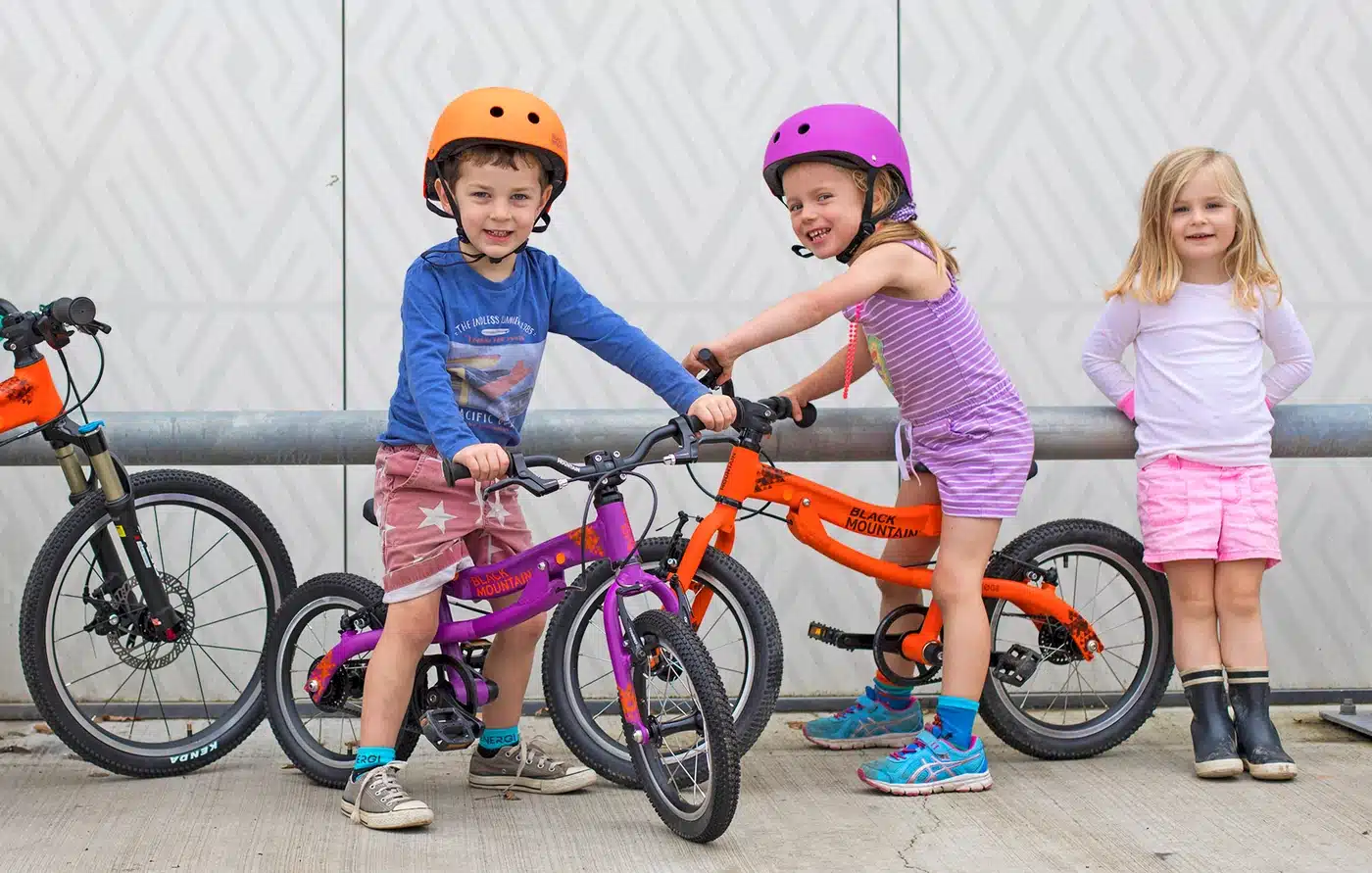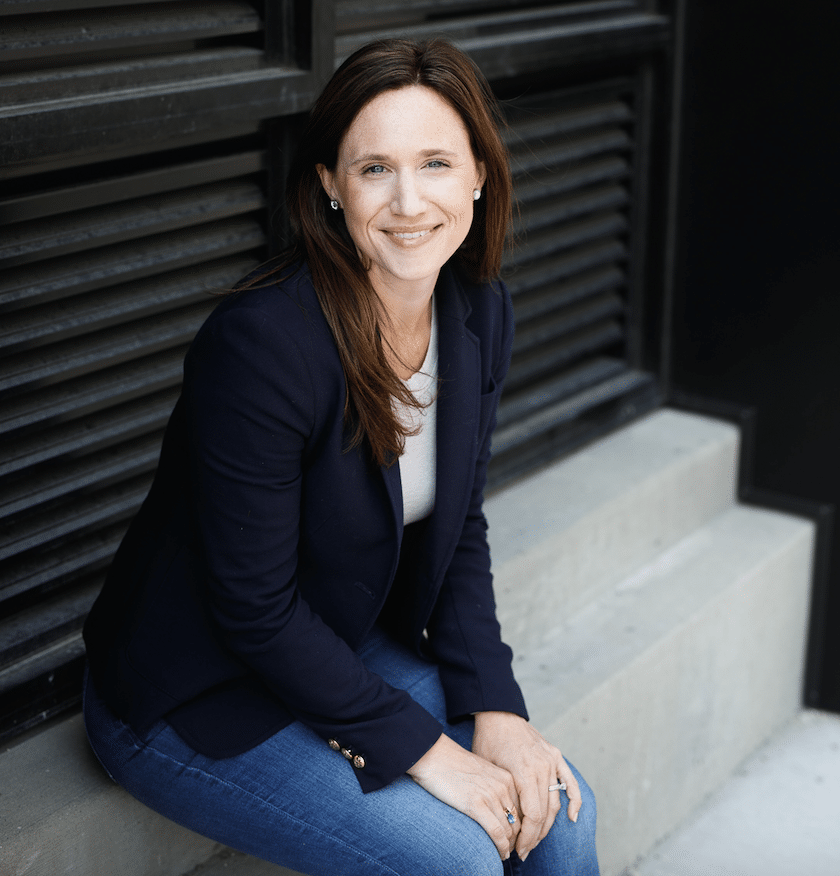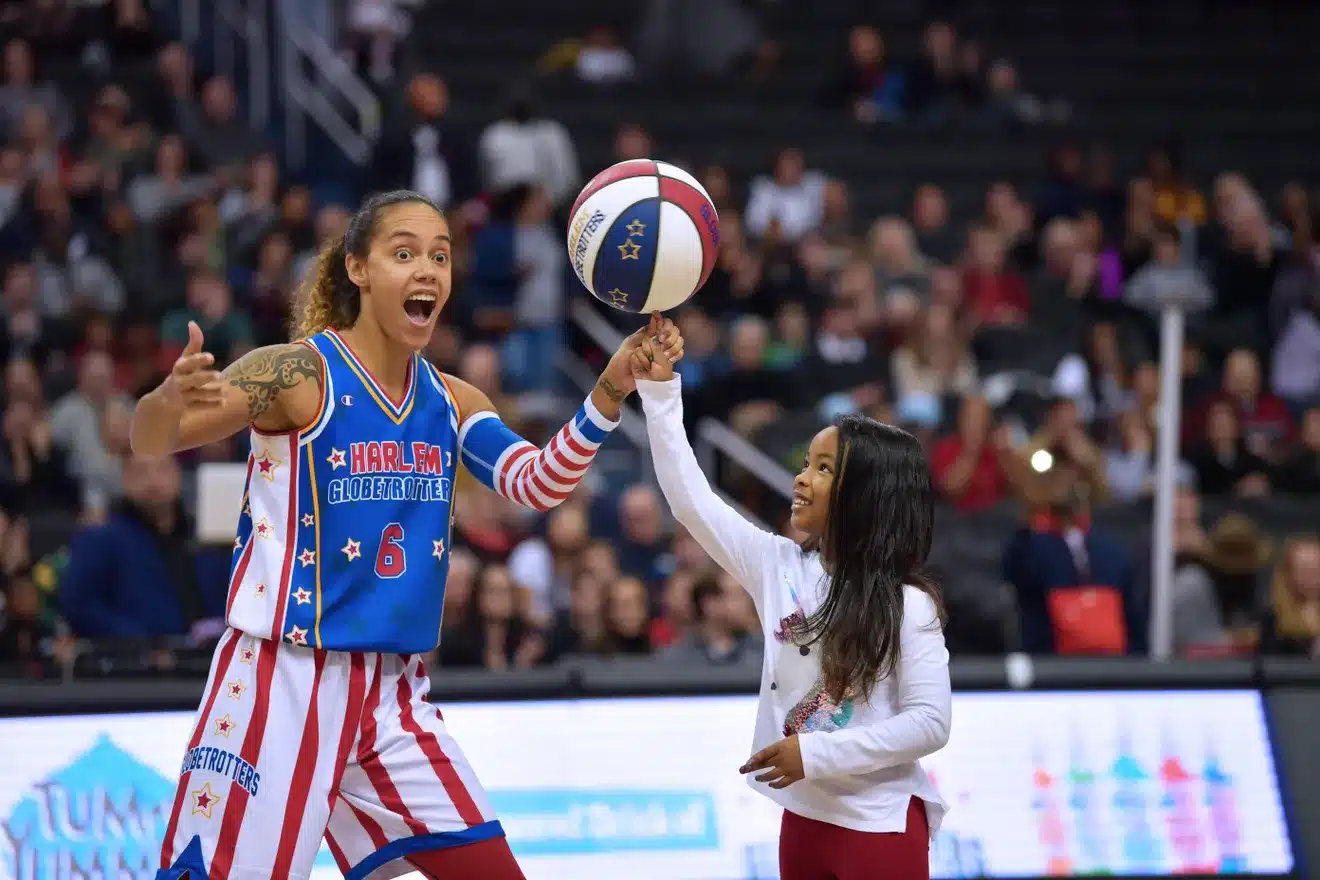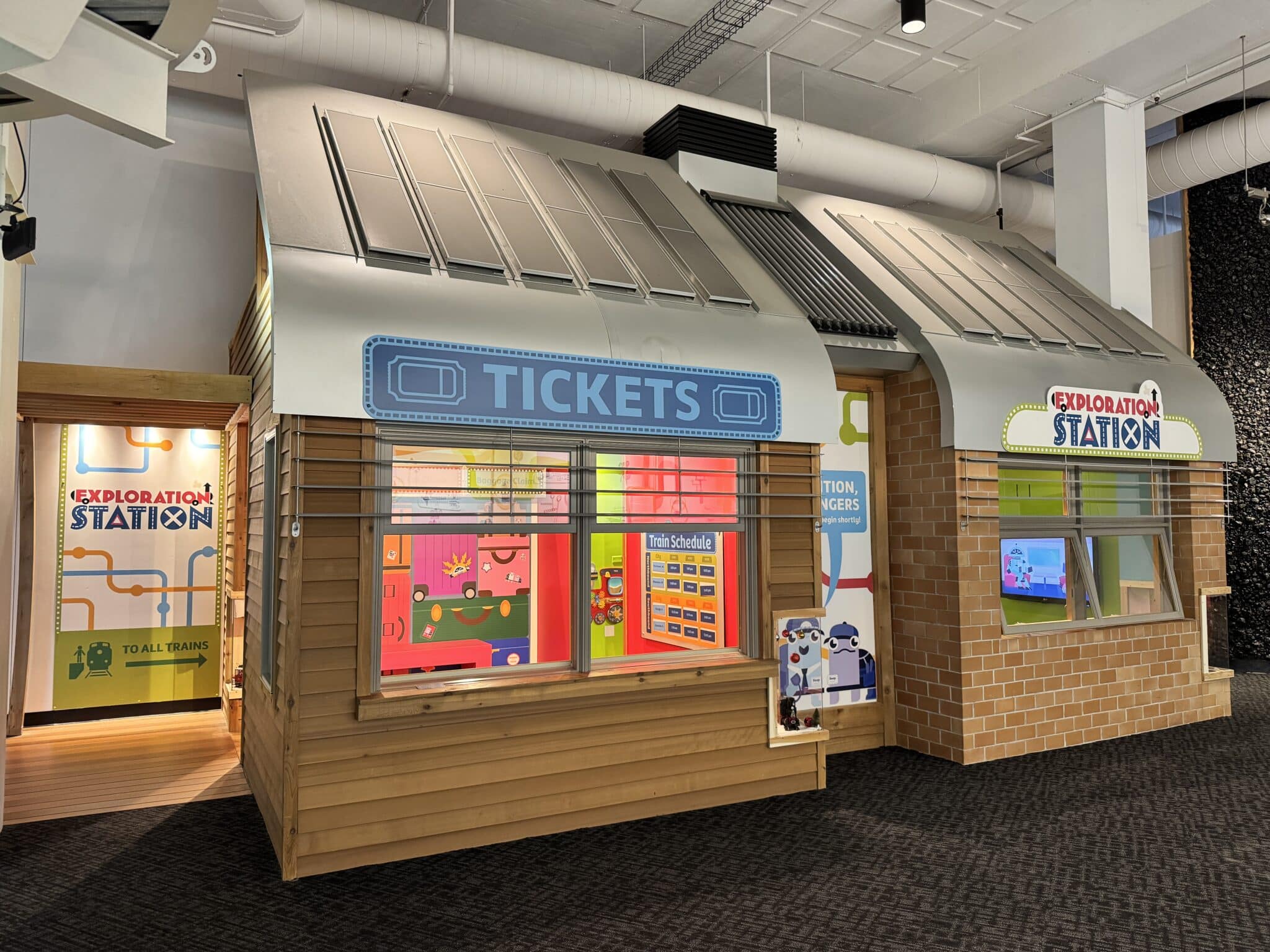Learning to ride a bike is the quintessential childhood rite of passage. With it comes confidence, more freedom, the opportunity to overcome obstacles, and lots of good memories.

It also means more physical activity, and more time outside enjoying the fresh air.
When you’re choosing your child’s very first bike, it can be an overwhelming decision. There are endless options on the market, and different considerations to make than when you are buying adult bikes.
The good news is that we are here to help. In this article, we first break down what factors you should consider when deciding on a new bike.
Then, we list the best bikes we could find for little kids. (Scroll down to skip right to the bikes!)
All of our recommendations are easy for kids to learn to pedal on, durable enough to be handed down or resold at a high value, and lightweight enough to make biking easy and fun.
Together, let’s find you the right bike!
Factors to consider:
Start With a Balance Bike
Balance bikes have totally changed the way kids learn to ride a bike. Training wheels are simply not as effective at helping a child learn to maneuver and handle a bicycle.
We recommend buying a balance bike, and then buying a regular bike right after that. Skip the training wheels, despite the nostalgia you may feel towards them.

A balance bike looks like a regular bike, but it has no pedals. Little kids will instead push with their feet to move along the road, and then pick up their feet to glide. They learn to balance and maneuver a bike, but with the added security of being able to put their feet on the ground.
When they’ve mastered the skill of balancing and gliding, and they are tall enough for a regular bike, they will literally just hop on the bike and pedal away.
You can start a child on a balance bike right when they start walking.
Many bike experts agree that the best balance bike is a Strider Bike, and for good reason.
The Strider 12 Spot Balance Bike is lightweight (less than 7 pounds), easy to assemble, and can be adjusted to many heights (a 9 inch span!). They were build with a small child in mind, as the handlebars are narrow, and the grips are child-size. There are also footrests for kids who are ready to try hopping and jumping on their bike, or who like to relax on a downhill slide.
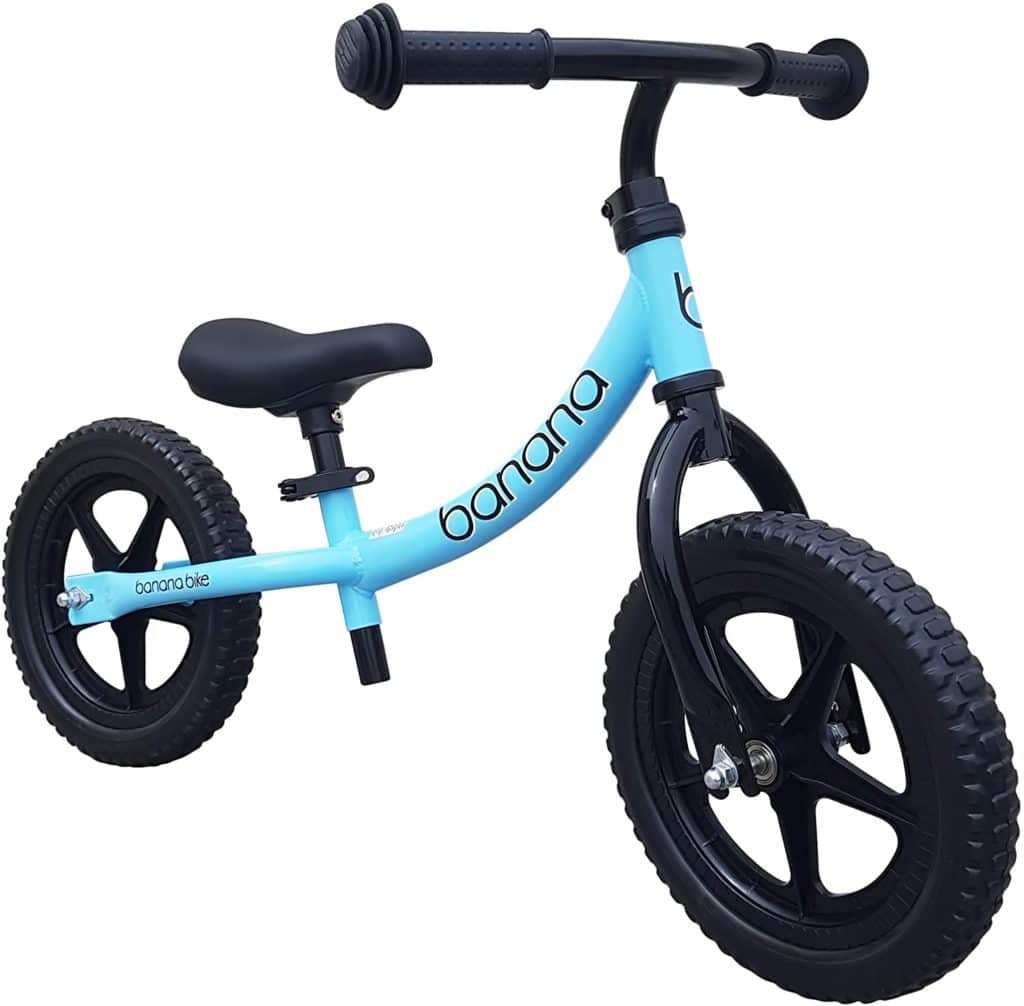
If you’re on more of a budget, opt for the Banana Bike. It has a steel frame, making it a bit heavier, and it is more difficult and cumbersome to assemble. Plan on an hour to assemble yourself, or plan to take it to your local bike shop so they can make sure it is done completely correctly.
But this balance bike is well-made, and has some handlebar height adjustability (3 inches or so).
Wheel Size
Once your child is ready for a pedal bike, you’ll want to get the right size.
Kids bikes come in all different sizes, and they are often described in terms of the wheel diameter. The wheel diameter is the distance, in inches, measured across the face of the wheel.
When you’re shopping for a regular pedal bike, look for a bike with a large wheel size. A larger wheel size makes it easier for your child to roll over the obstacles in their way. As they ride, they’ll encounter cracks in the road, rocks, sticks, pebbles, and bumps along the way.
While your child’s actual body measurements are more important than your child’s age in determining the size of the bike you need, you can start with these guidelines as a general rule of thumb:
For a 2 year old, 12 inch bikes will likely be a good fit.
For a 3-5 year old, a 14 inch wheel is your best beet.
For a child 5-6 years old, you can opt for 16-inch wheels.
For older kids ages 6-10, 20-inch wheels are typically the right size.
If your child is very large or very small for their age, adjust accordingly.
Here is an excellent bike sizing guide.
Bike Height
Many parents opt to size up when they are choosing a bike, but it’s important to buy a bike that fits your child right now, rather than a bike they will grow into. Buying a bike that is too big for your child can very easily hamper the learning process. Purchasing the right size bike is crucial to your child’s biking experience.
If a bike is too big for your child, it can be much more difficult for them to maneuver and handle it for the first time. This can make learning to ride their bike more frustrating and less fun. It’s a good idea to make your child’s first experiences on a bike to be positive and enjoyable, so you’ll want the bike to be the perfect fit for them.
Instead of measuring your child’s height, measure their inseam.
When young children are just learning to ride a bike, they learn the best if they can put their feet flat on the ground. This means that your child’s inseam should be as long as the minimum seat height.
For younger kids who have a lot of experience on a pedal bike, their inseam should be about two inches less than the bike’s seat height. This will allow for the appropriate leg extension while they’re pedaling.
The best way to measure the inseam is to have your child stand with their feet flat against a wall and place a book in between their legs until it is firmly on their crotch. Then measure the nearest inch from the top of the book to the floor.
If your child is in between sizes, opt for the smaller size, unless they are right on the cusp of the larger size. (Even though you probably want to size up, the wise choice is to opt for smaller.)
Look for a bike with a generous adjustable seat height so that your bike can grow with your child for as long as possible.
Bike Weight
Another important thing to consider is the weight of the bike. The weight of the bike will affect its handling and the ability of your child to ride for longer distances without tiring.
The lighter the bike, the longer your little rider can ride comfortably. This is a really important factor to consider. Try to find a bike that is about a third of your child’s body weight.
Young kids should be able to pick the bike up easily. If they cannot pick it up easily, then imagine them trying to pedal it up a steep hill.
The frame material will contribute greatly to the bike’s weight. A lightweight aluminum frame will make for a nice, easy ride. Aluminum is a lighter material than steel, but a durable steel frame is a classic, popular choice, as well.
Bikes that are inexpensive also tend to be very heavy, so keep this in mind as you make your decision.
Bottom line? Heavy bikes are harder to ride. Lighter bikes make for an easier ride.
Geometry & Ergonomics
Look for a bike that is built with younger children in mind.
For example, it should have a longer wheelbase. The wheelbase is the distance between where the two wheels of a bike touch the ground. Bikes with longer wheelbases are generally more stable and easier to balance.
Good geometry for kids’ bikes also mean having a narrow distance between the pedals (this is sometimes called a Q-factor). The larger the Q factor, the farther apart your feet will be.
Finally, a child’s bike should have a low center of gravity because it makes it easier for kids to balance on.
These important factors all contribute to a more stable and comfortable ride for kids.
Terrain
Ask yourself what terrain your child be riding on most often. Will they be mostly riding on city sreets and sidewalks? Will they be riding on paths with a lot of gravel and dirt? Asking yourself these questions will help you decide if you need mountain bikes, road bikes, or a hybrid.
Mountain bikes are generally suited to off-road riding, cycle up a steep hill, or cycling over loose gravel. On smooth roadways, their ability to maneuver significantly reduces. Mountain bikes also tend to be heavier.
The Coaster Brake Debate
A coaster brake on a bike is a braking system that is set in motion by pedaling backward.
Some bike experts caution against using coaster breaks because when kids are learning to pedal, they tend to naturally backpedal. If their bike has a coaster brake, a natural backpedal can cause a sudden stop, which can cause an injury or simply be frustrating to little ones who are trying to learn to ride.
Instead, these experts recommend using only hand brakes to control the front and rear brakes.
However, most manufacturers still make their bikes with coaster brakes. The US Consumer Product Safety Commission (CPSC) requires a coaster brake on every youth bicycle sole in the US today. This means you cannot get a kids’ bicycle without one.
If you don’t want your child using the coaster brakes, you can have a wheel built or re-laced after you purchase the bike.
Hand Brake Levers
Your bike should have hand brakes, with brake levers that are easy to pull. (Woom bikes have color-coded brake levers. See below for more details on that.)
Test out the brake levers with your smaller fingers, or have your child test them out to ensure they are easy to use. This is extremely important for safely. Your child needs to be able to brake quickly, easily and effectively.
Chain Guards
Your child is likely going to fall off their bike at some point, so it’s a good idea to have a chain guard.
A chain guard is an enclosure for the bicycle chain that protects your child from being soiled or trapped in the chain if they fall.
Gears
Most experts agree that gears aren’t needed for your child’s first bike. They are an unnecessary complication at this age, and add pointless weight to the bike.
Price
Many of the bikes that are made especially for kids are more expensive than the bikes you’ll find at your local bike store. This is because they are custom-made just for kids and a child’s experience riding.
Cheap bikes that you can buy at big box stores or department stores tend to be heavy, and have poor design that makes riding more difficult for kids.
If you buy a more expensive, higher-quality bike, you can resell it later on, or pass it on to a sibling.
If you are on a budget, a great way to get one of these higher quality bikes is to buy it used from someone in your community or on E-Bay.
Best Bikes for Little Kids
Your child’s first pedal bike is an exciting purchase! Now that you’ve read through the factors you should consider before purchasing, here are the best kids’ bikes in 2022:
1. Woom
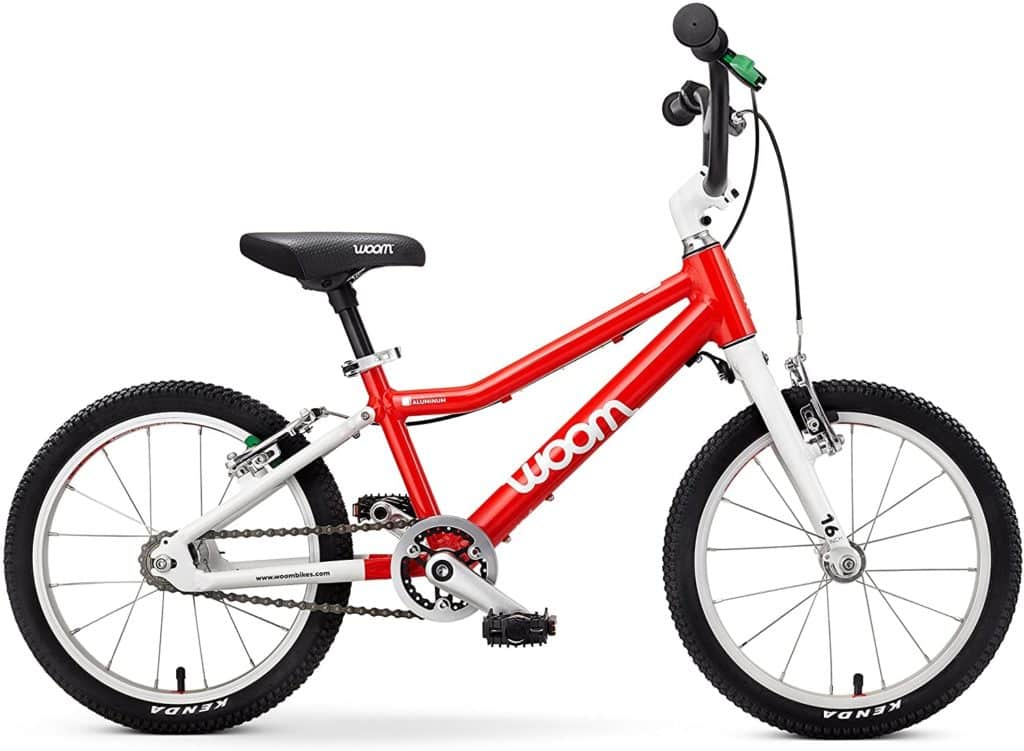
Almost every bike expert agrees that the high quality Woom bike is the best kids bike on the market, for younger and older children.
They are the lightest on the market, making it easy for kids to maneuver and manage. The 14 inch model is just 11 pounds.
The design centers the child’s weight over their hips and keeps the child in a comfortable and upright position.
They offer a color-coded hand-brake levers that promote safe braking. The right-hand lever is green, which is an intuitive color for kids to use.
To comply with the CPSC requirement, the bike ships with a coaster brake, but there is also an optional freewheel kit to get rid of the coaster brake after it arrives at your home.
However, for kids who are aggressive riders, Woom may not be the best choice, because of the upright seating position.
2. Guardian
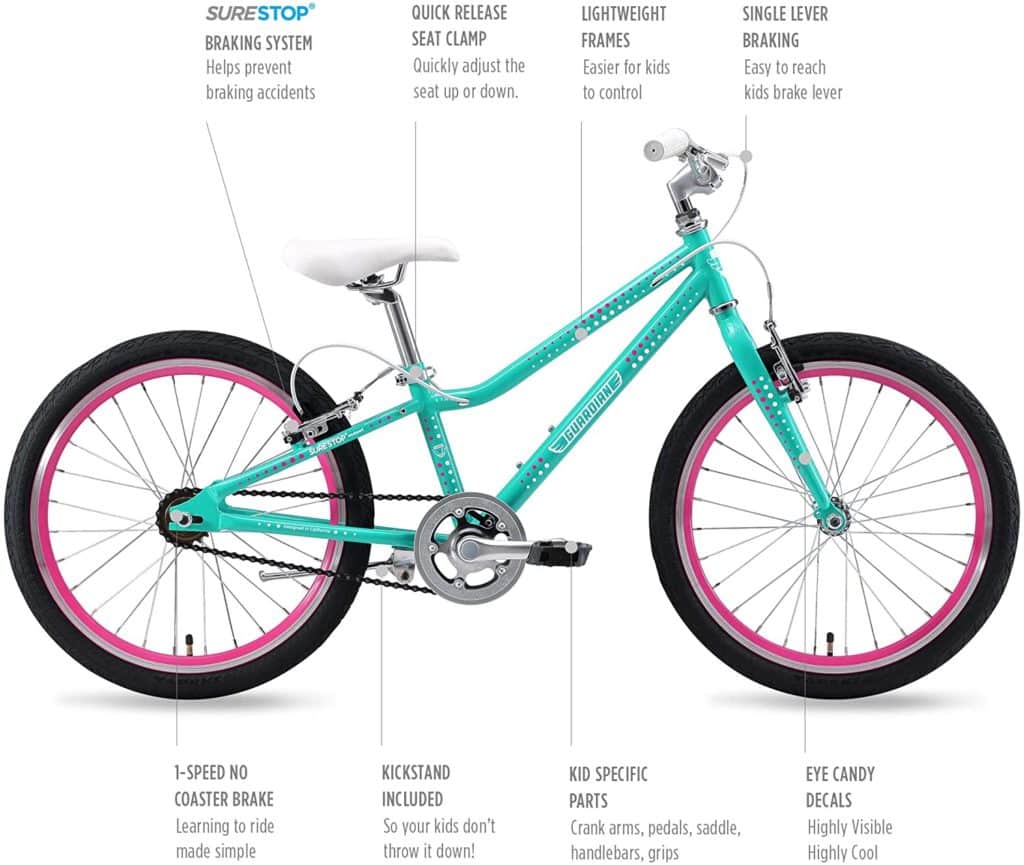
Guardian bikes are a good choice for parents who are especially focused on safety features. The standout feature of a Guardian bike is the SureStop braking sytem. It has a since brake lever on the right hand that activates the rear and front brake at the same time. It also does not have a coaster brake (back pedal brake), and this is really helpful for little ones who are just learning to pedal.
By training kids to rely on their right hand brake, the system can prevent injuries in the future. This is because braking with the front brake only (usually found on the left hand size) can cause kids to flip over their handlebars.
One downside is that this bike may be a bit heavier than the competition due to its sturdy steel frame which the company refers to as “lightweight”.
3. Co-op Cycles REV 12 Kids’ Bike
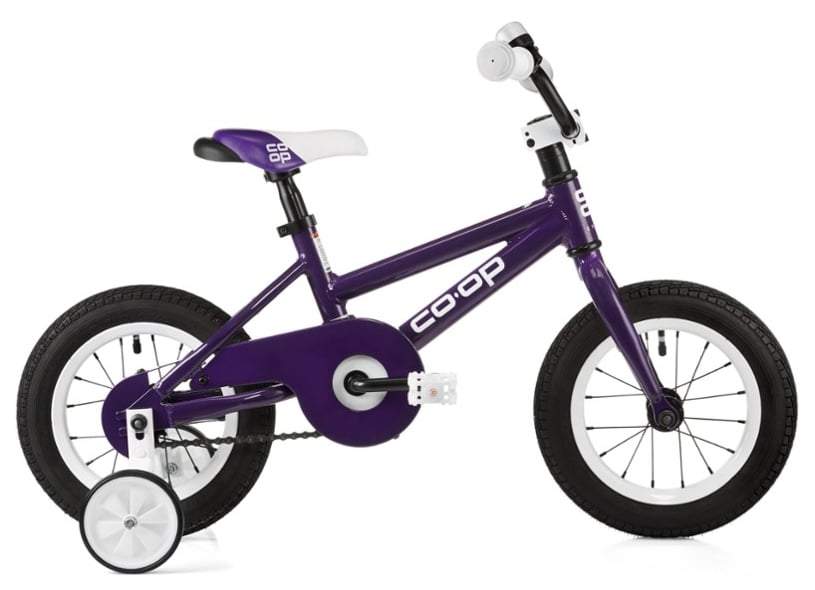
The Co-Op Cycles REV 12 is a light-weight bike on a budget and if you get it at REI, you can take advantage of their generous return policy. That way, if it doesn’t work out, you aren’t locked into your choice.
The bike is aluminum and comes with training wheels, a bell, and stickers to personalize their new ride. The Innova tires make it easy for kids to maneuver obstacles. There is a coaster brake. There are lots of color choices to select from.
This bike does require a tool to adjust the seat, and the handlebars cannot be adjusted.
4. Batch Bike

Batch bikes are heavier than some of their competitors, but they are durable, built to last and have good geometry for children.
Plus, they are more affordable, and they are often available at local bike shops, unlike many other bikes on this list. There is also a quick-release seatpost collar, making it easy to adjust the saddle height.
On the con list, there are no hand brakes, and no quick release skewer, which is a mechanism for attaching a wheel to a bicycle. There is also a bulky chain guard.
5. Raleigh MXR ($145)
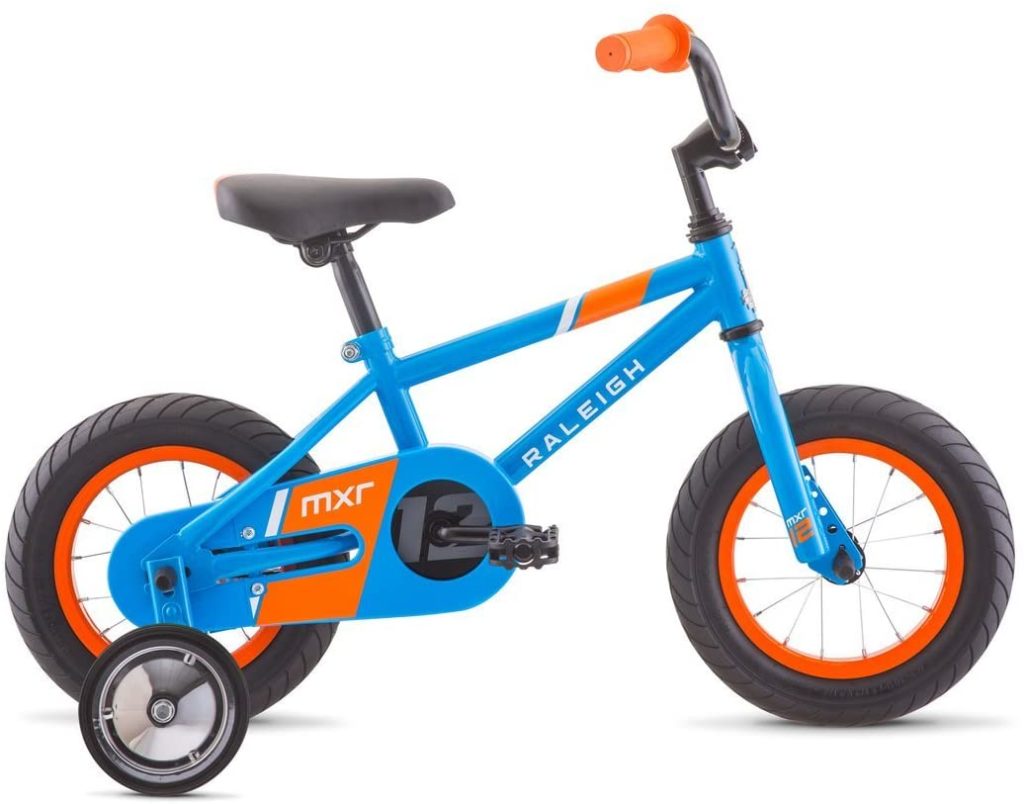
Raleigh bikes are another option that won’t break the bank, but will offer great geometry and functionality at a good price. There are all different styles for all different sizes and ages.
The Rowdy model is a mountain bike that is perfect for aggressive, confident riders because it has a longer reach and extra wide handlebars. It has a lightweight frame, dual-hand brakes (no coaster brake), and enables kids to be able to take extra wide turns and jumps.
The design does make it more difficult to complete narrow, quick turns.
6. Frog 40 Starter Bike
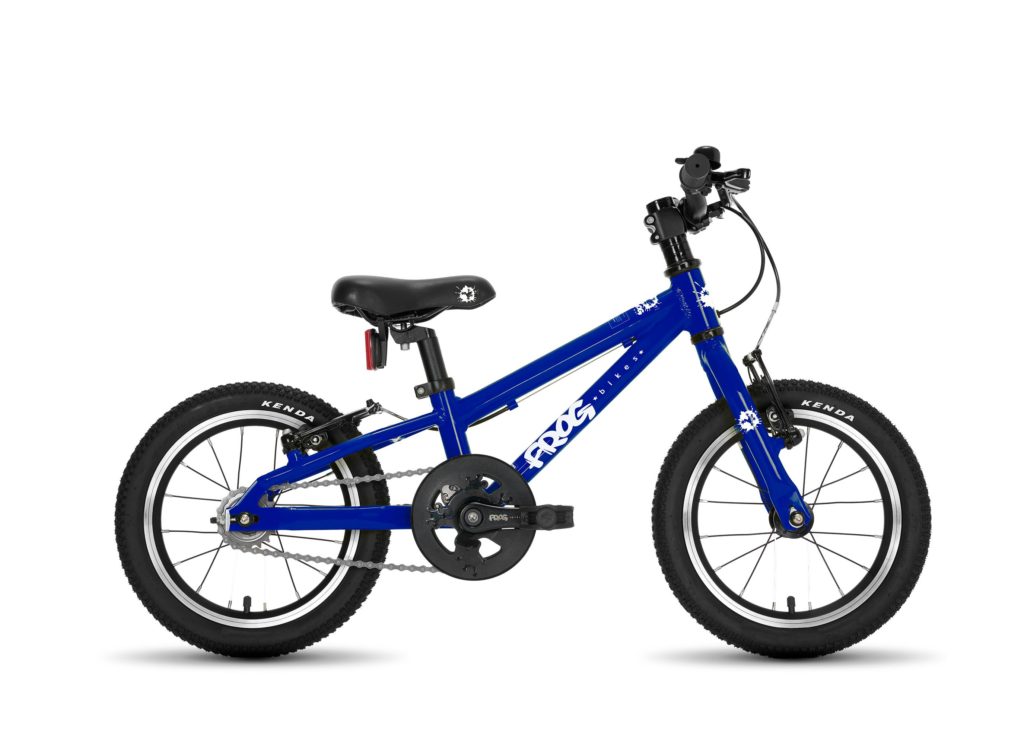
The Frog 40 bike is designed for three to five year olds. It comes with 14 inch wheels and the addition of Tektro brakes, which the company says are small and easily to reach. They are also adjustable. This makes the child feel more in-control and builds confidence. There is just one gear, making the ride simple, and the experience just plain fun. There are also lots of fun color options.
The Frog 43 was recently redesigned into the Frog 40, allowing a smaller child with a 15 in inseam to fit the bike.
The Frog 40 is designed to be lightweight with an aluminum frame and quality component that are high-performance but don’t weigh the bike down. It weighs 13.9 lbs.
One key feature is the patented frog cranks, which reduce the distance between pedals for increased comfort and efficiency. They also include Kenda knobby off road tires that work well on any terrain or road. The safety steering lock prevents oversteering which can cause an accident. It’s safer for beginning riders, but still nimble enough for more adventurous riders.
It also comes with mudguards that are easily to install, 6 reflectors (one for the front, one for the back, and four for the wheels), and a bell to let others know you’re coming!
7. Cleary Gecko ($310)
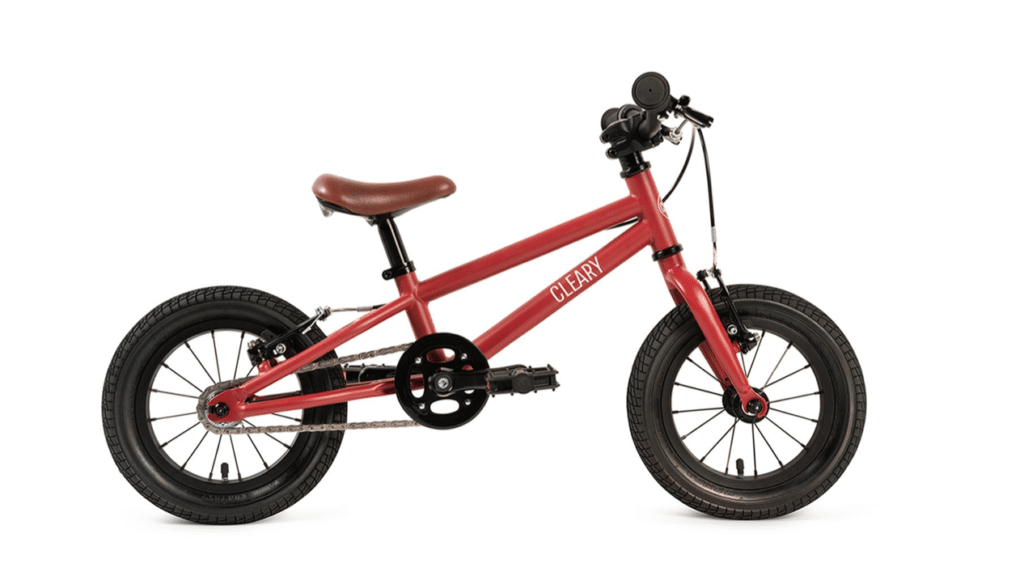
The Cleary offers really good quality to the discerning bike consumer, and is a great bike for little one who is ready to ride early. They have a great 12” option that has just one gear, and is perfect for kids with an inseam measurement of up to 18’. The 12″ bike actually has the potential to last a couple of years if you start with a 14” inseam measurement. There is a handle under the saddle for a grown-up to help get them started. It does have a steel frame, so it is not the lightest on the market, which can be tough especially for the youngest riders.
8. Islabikes
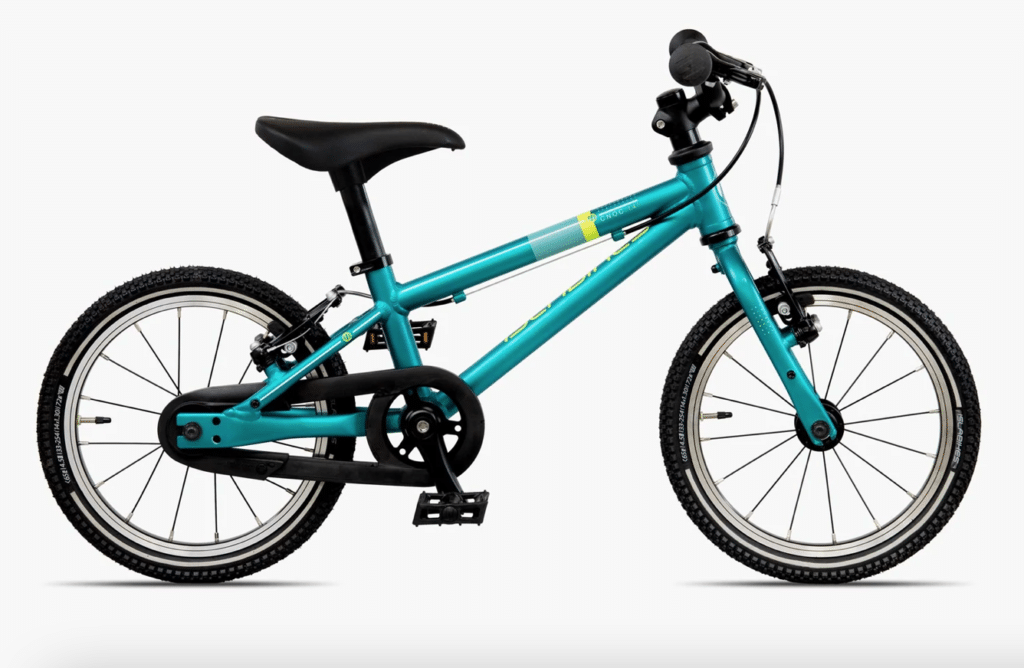
Islabikes is the top pick for a very high-end bike. This trendy British company has a great reputation for designing high-quality bikes and fostering a passion for cycling in children.
These bikes are in the luxury category, and much attention is given to make sure the bikes fit well, ride well, and are light enough for small children to easily manage.
The Rothan offers a lightweight aluminum frame, chunky tires with lots of grip and a brake perfectly designs for little hands. There is a range of bright colors to choose from.
9. Black Mountain Bikes
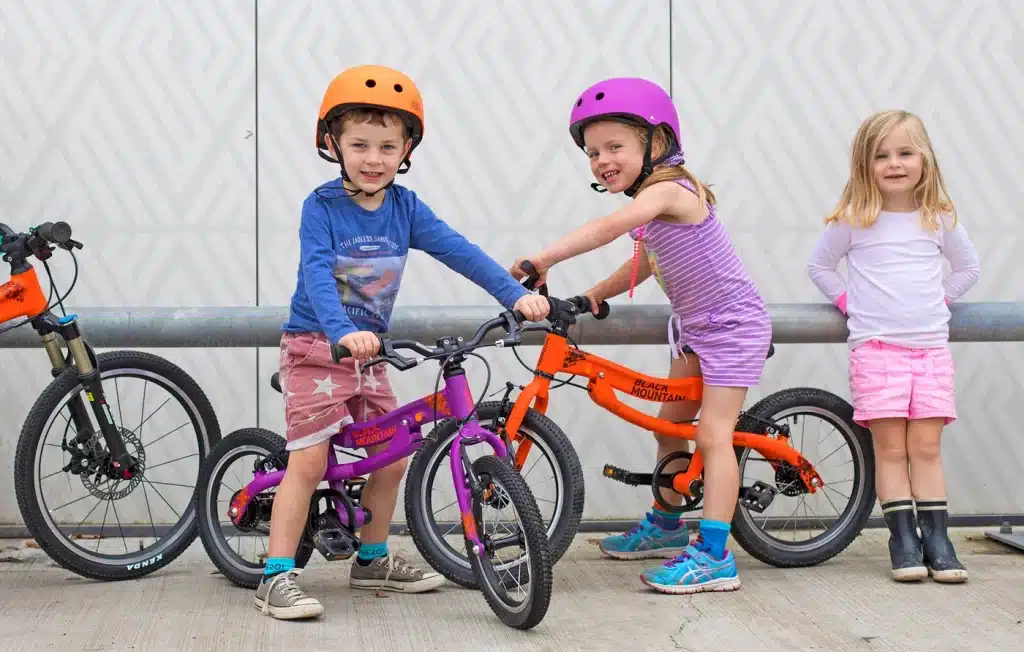
Black Mountain Bikes is a great choice for a parent who appreciates a bike that will grow with a child. They offer some options that are “three bikes in one”, called the Pinto and the Skog.
These models can work as balance bike, a regular pedal bike, and a more advanced bike, so the bike is good for a little kid or a big kid.
They are light weight with good-quality brakes and levels that are suited for small hands.
10. Joystar (129.99)
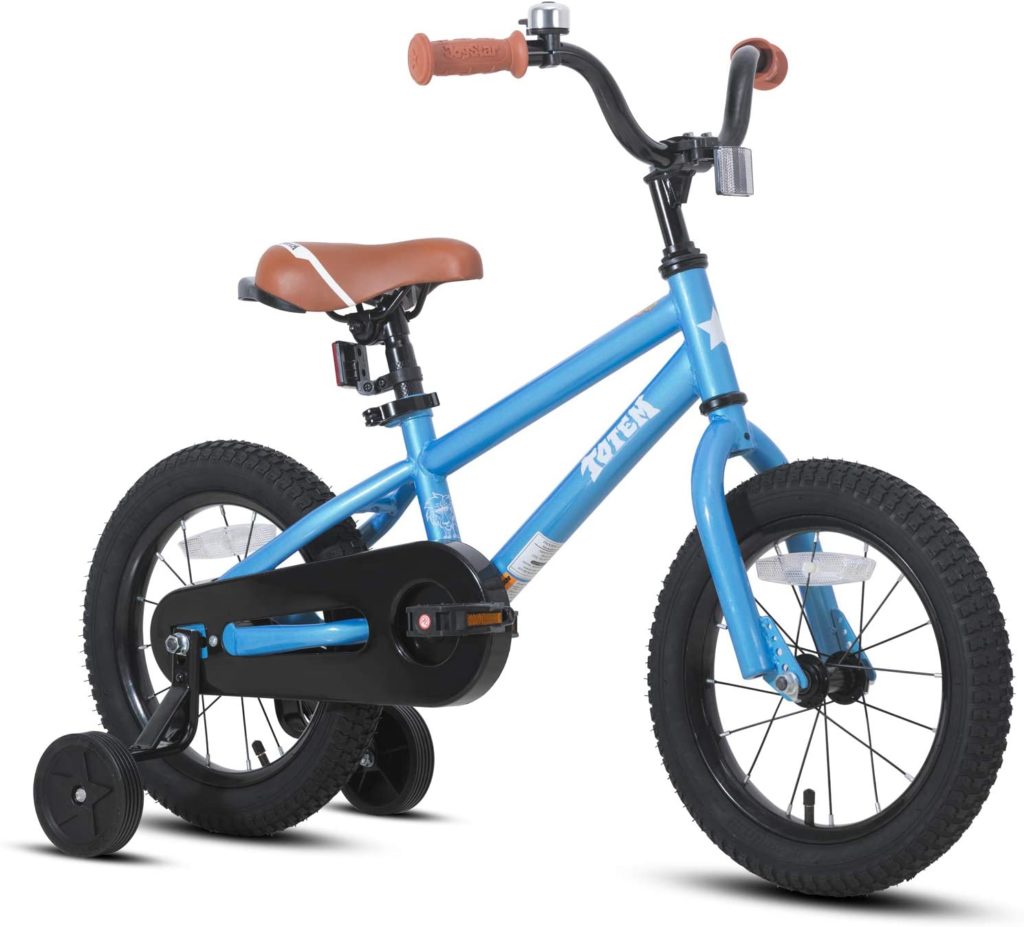
Joystar is the perfect bike for buyers on a budget, and they offer a range of bikes for ages 2-9, so you can find a bigger bike here, as well. They are affordable, high-quality and will last for many years thanks to its durable steel frame that can withstand bumps and heavy use.
The Totem comes with removable training wheels that come off easily once your child masters balancing (preferably on a balance bike – see above for our guidance on that).
The Totem also comes with a single-speed making it easy for your little one to use. The saddle also has a handle so that a grown-up can help with balance at first. The tires are wide and durable, there is a chain guard, and it also has a foot coaster brake. (Read more above about the great coaster brake debate.) The bike also comes with a lifetime warranty.
Conclusion
In summary, we recommend starting with a balance bike rather than using training wheels, and then purchasing a regular pedal bike. Balance bikes are much more effective in teaching a child how to balance and maneuver a bike than the training wheels many of us used as kids.
Before purchasing your pedal bike, determine what wheel size you need based on your child’s age, and what height your bike should be based on your child’s inseam measurements.
When your child is in between sizes, you should opt for the smaller size (rather than getting a bike your child can grow into), because a larger bike can be very difficult to maneuver and make the experience frustrating and negative for your child.
An extremely important consideration is the weight of the bike. It should weigh about a third of your child’s weight, and they should be able to carry their bike easily. A lightweight bike will allow a child to ride more easily for longer distances and makes for a more pleasant riding experience.
You’ll want to consider the geometry of the bike, and opt for a design that is suited for children. A longer wheelbase, a narrow distance between pedals (Q-factor), and a low center of gravity are all important factors to consider that will make your child’s ride more stable and comfortable.
You’ll also want to think about what kind of terrain your child will be riding to determine if you need a mountain or road bike.
Most experts agree that chain guards are a good idea to have, and that gears are not necessary for a child’s first pedal bike.
It’s likely that your bike will come with coaster brakes since it is required in the USA, though some experts recommend getting these removed after you’ve purchased the bike, and instead relying only on the hand brakes.
Although there are some strong options for families on a budget, many of the big box bikes are too heavy and not well made. Higher quality bikes will last longer and will retain resale value. If you are on a budget, you can check on E-Bay or in your community for a used bike.
Cycling is such a fun activity that can last throughout your child’s entire life. Regardless of what bike you choose, we wish you many years of fun, safety, and memorable family rides on your brand new bike.
Calie Herbst, Editor-in-Chief of Milwaukee With Kids, has spent over a decade combining her experiences as a parent of three to create a hub for Milwaukee’s family adventures.
Her decade-long teaching career in Milwaukee Public Schools and academic background, including a Master’s in Teaching from Marquette University and dual B.A.s in Sociology and Spanish from the University of Wisconsin – Madison, fuel her passion for inclusive and engaging family content.
Calie is also a recognized voice in local media, contributing to WISN Channel 12 News, WTMJ Wisconsin Morning News, Fox 6’s Real Milwaukee, and B93.3.
Discover more about Calie’s journey and editorial approach on her About Page and Editorial Policy Page.


